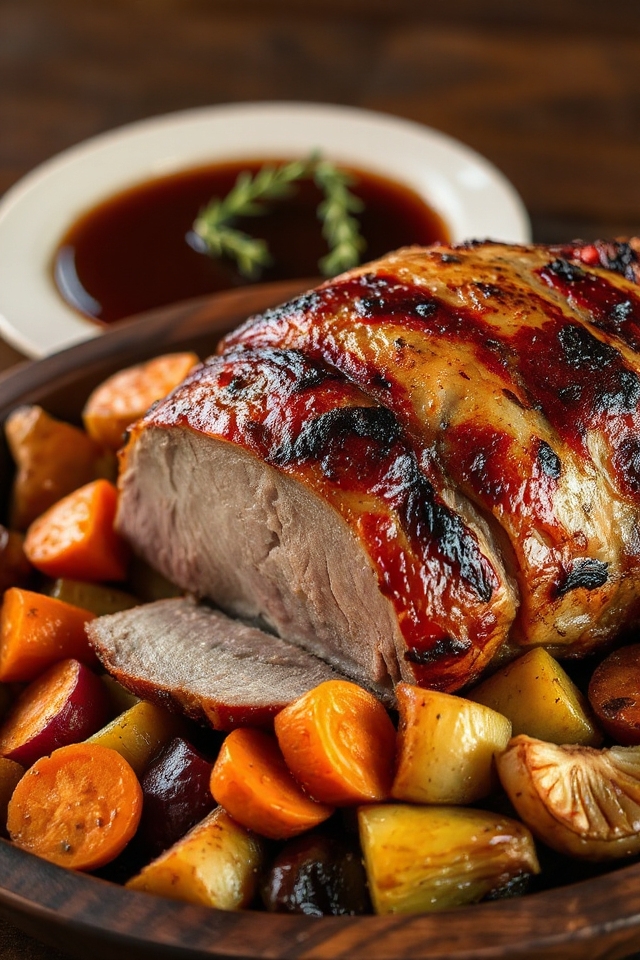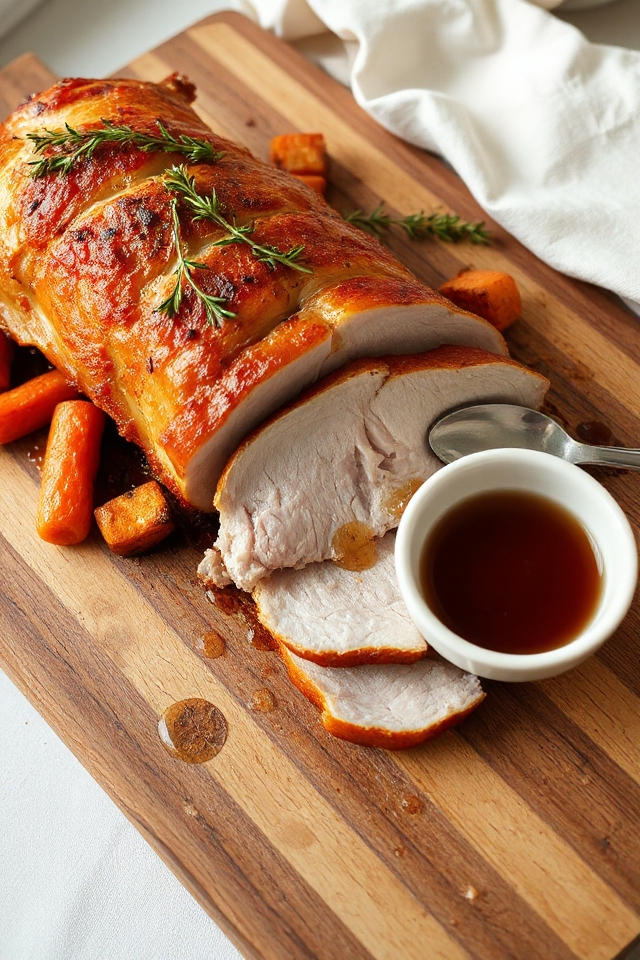Why You’ll Love this Roast Pork Recipe
When you taste this roast pork recipe, you’ll quickly understand why it’s a favorite in my kitchen. The combination of garlic, thyme, and olive oil creates a savory crust that locks in moisture and flavor. Each bite melts in your mouth, delivering a perfect balance of tenderness and seasoning.
I love how the slow roasting process allows the meat to absorb the essence of the vegetables underneath, enhancing its richness. Plus, the simplicity of the preparation makes it an ideal dish for gatherings. It’s truly comforting, and I can’t wait for you to experience it for yourself!
Ingredients of Roast Pork
When it comes to making the perfect roast pork, the ingredients are key to achieving that mouthwatering flavor and tender texture we all crave. This recipe calls for some simple, yet powerful ingredients that work together beautifully. You’ll be amazed at how a few pantry staples can create such a delicious meal.
So, let’s gather up what we need and get ready to roast!
Here’s what you’ll need for this roast pork recipe:
- 6 lbs pork loin (with 5-6 ribs, each chine bone removed)
- 2 tablespoons kosher salt
- 3 medium garlic cloves, minced (about 1 tablespoon)
- 2 teaspoons ground black pepper
- 2 teaspoons dried thyme leaves
- 2 tablespoons olive oil (for the rub)
- 1 small carrot, cut into 1-inch chunks
- 1 small onion, chopped
- 1 tablespoon olive oil (for the vegetables)
- 3 tablespoons Madeira wine
Now that we’ve got our ingredients lined up, let’s talk a bit more about them. The pork loin is the star of the show, so you want to make sure you pick a good one. Look for a nice cut that has a bit of marbling; it helps keep the meat juicy during roasting.
As for the seasonings, feel free to adjust the garlic and thyme to match your personal taste. After all, cooking should be fun and a little creative.
And don’t forget about the vegetables; they aren’t just for show. They soak up all those tasty drippings and add depth to your jus. So, let your inner chef shine, and let’s move on to how to make this delightful roast pork!
How to Make Roast Pork

Alright, folks, let’s plunge into how to make that roast pork you’ve been dreaming about. First things first, if you’re feeling adventurous (or just want to impress), you might want to dry age your pork loin a bit. Grab that 6 lbs pork loin and rub it all over with the 2 tablespoons of kosher salt.
Place it on a wire rack set over a jelly roll pan lined with paper towels. Then, just let it chill in the fridge, uncovered, for about five days. Yes, five days. It sounds like a lot, but trust me, it’s worth the wait for that tender, flavorful meat. On roasting day, shave off the hardened bits from the ends of the loin, and you’re good to go.
Now, let’s whip up that garlic-thyme rub. In a bowl, mix together the minced garlic (that’s about 1 tablespoon from three medium cloves), 2 teaspoons of ground black pepper, 2 teaspoons of dried thyme leaves, and 2 tablespoons of olive oil. You’re looking for a thick paste here. Smear that glorious mixture all over the pork loin like you’re giving it a spa treatment. It’ll thank you later.
While you’re at it, toss a small carrot, cut into 1-inch chunks, and a chopped small onion with 1 tablespoon of olive oil and spread them out in a large roasting pan.
Now, preheat your oven to a low 250 degrees. Place a large roasting rack over the veggies and set your beautifully seasoned pork on the rack. Roast it until the internal temperature reaches 120 to 125 degrees F—this will take about an hour and a half. The low and slow method gives you that juicy texture we all love.
Once you hit that temperature, crank the oven up to 425 degrees and continue roasting until the internal temperature hits 145 degrees F, which should take around 30 more minutes. Don’t forget to add a cup of water to the roasting pan halfway through to keep everything nice and moist.
Now, when the pan drippings start to brown and smoke just a bit, take it out and let that pork rest under some foil. The temperature will rise a little more during this time, so keep an eye on it.
And there you have it! While the meat rests, we can make a simple yet delicious jus. Strain those pan drippings into a measuring cup (don’t forget to press on the veggies to release every last drop), skim off any fat, and add enough water to make a full cup.
Toss in those 3 tablespoons of Madeira wine, and simmer it for about five minutes to blend those flavors. This jus will elevate your roast pork to another level—trust me, it’s worth every bit of effort.
Roast Pork Substitutions & Variations
If you’re looking to shake things up with your roast pork, there are plenty of substitutions and variations to contemplate. Instead of pork loin, try using a pork shoulder for a richer flavor and more tender texture.
If you want a different seasoning profile, swap the thyme for rosemary or sage. For a tangy twist, marinate the pork in citrus juices like orange or lemon. You could even experiment with a spicy rub using paprika or chili powder.
Don’t forget to try different vegetables like sweet potatoes or bell peppers in your roasting pan for added depth and color!
What to Serve with Roast Pork
After exploring various ways to customize your roast pork, it’s time to think about what to serve alongside it.
I love pairing my roast pork with creamy mashed potatoes or roasted sweet potatoes for a comforting side. A fresh apple or cranberry sauce adds a delightful sweetness that complements the savory pork beautifully.
For greens, sautéed green beans or a vibrant spinach salad with a tangy vinaigrette brighten up the plate. Don’t forget some crusty bread to soak up the delicious jus!
These sides create a well-rounded meal that everyone will enjoy at the dinner table.
Additional Tips & Notes
While preparing a delicious roast pork, it’s essential to keep a few tips in mind to elevate your dish.
First, don’t skip the dry aging step; it really enhances flavor and tenderness.
When applying the garlic-thyme rub, make sure to cover every inch for maximum taste.
Always let the meat rest after roasting; this helps retain juices.
For a richer jus, consider adding herbs like rosemary or a splash of balsamic vinegar.
Finally, if you want crispy skin, blast the oven’s heat at the end.
Trust me, these little touches make a big difference in your roast pork experience!
